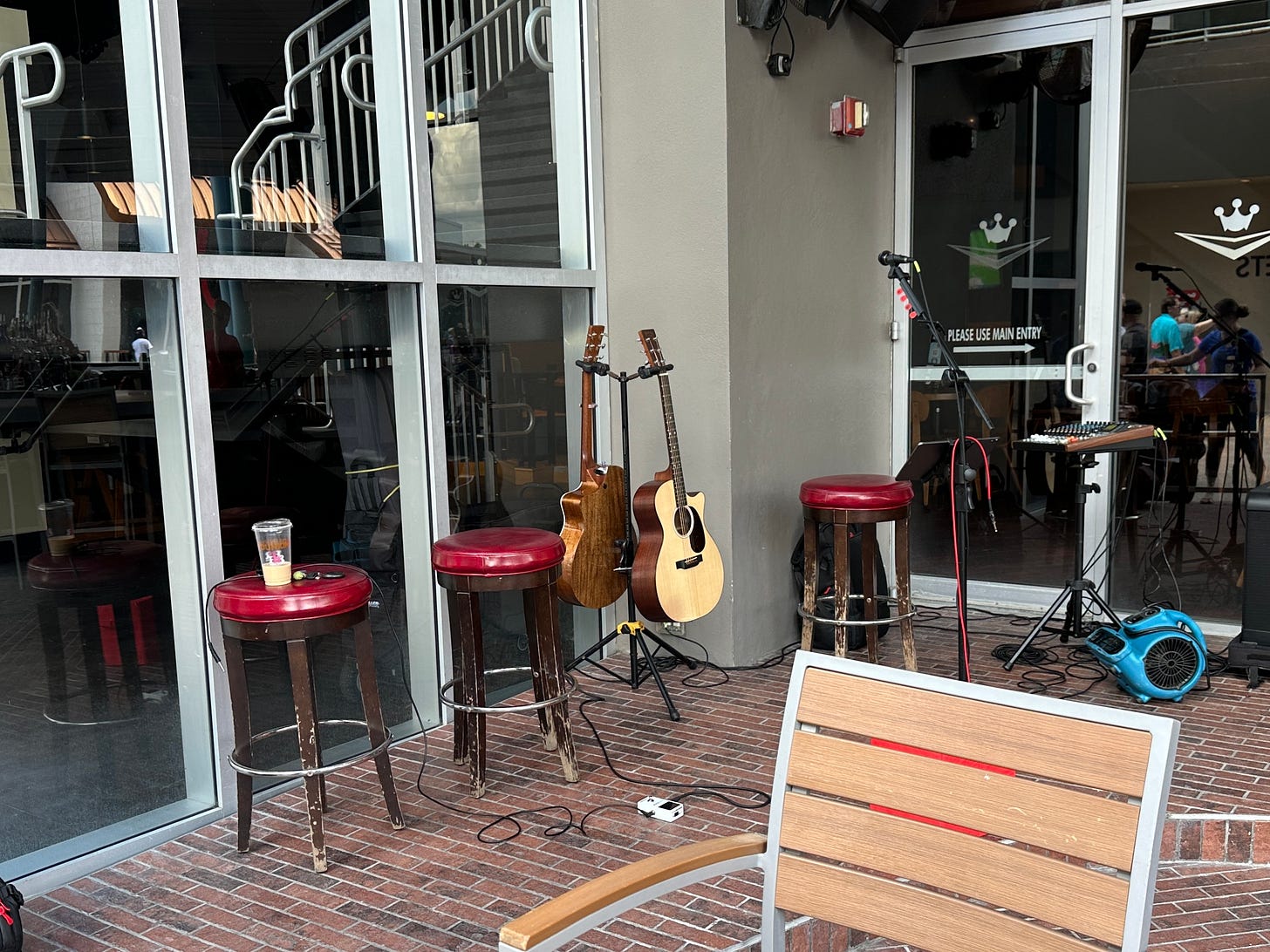RIFFS:
Last week we took the kids to Disney.
Here are four things I learned:
1/ Break time is over.
At The Edison in Disney Springs, the PMJ-style trio did:
30 minutes on,
20 minutes off.
🤦♂️
I saw this intriguing setup on two separate days…
…but never saw the musicians play. 🤷♂️
In both cases, I was embarrassed for them.
Who needs a break from the best job on earth?
2/ Low expectations = an opportunity to delight.
It’s a truism in any service business:
Customers are more impressed with how you handle problems than they would be if there wasn’t a problem in the first place.
But I think that’s also true of any area where expectations are low. At the theme parks, I was impressed by how they made waiting in line a more enjoyable experience:
the line for The Many Adventures of Winnie the Pooh was all hands-on kid games
the line for Peter Pan’s Flight had wildly clever interactive shadow play
Star Wars: Rise Of The Resistance has a mini-ride that leads up to the actual ride
Guardians Of The Galaxy: Cosmic Rewind & Avatar Flight Of Passage both have a series of rooms where the storyline unfolds
I’m using this strategy when talking to clients. We’re all so distracted these days that when I give them 100% of my attention & focus, they feel seen & heard. They feel great about hiring me, and I get the sale. Win/win.
3/ Artists vs Entertainers
We saw a band fronted by a former contestant of The Voice.
He was a great singer, and the band was killing. But the show was a complete dud. Why? The setlist didn’t serve the audience. The frontman mistakenly believed he was hired for the job of “Artist,” when in reality he was hired as an Entertainer.
I think the key distinction is “did I pay for a ticket?”
If I paid for a ticket—with the Artist’s name on it—then I’m on a journey curated by that Artist. I’m trusting the taste of the Artist. The Artist picks the songs. The Artist can teach me to like something I’m not already familiar with.
But most of the time, we musicians are Entertainers. And Entertainers are in the hospitality business. Entertainers are there to enhance an experience. Entertainers strive to earn the trust of their audience, but they’re starting from zero.
The world needs both…
…but it needs us to be clear about which job we’re doing.
4/ When to use tracks (and why)
We saw several bands using backing tracks.
What was interesting was what was tracks vs what was human.
There were two bands without a live bass player—the bass was in the track.
Those same bands both had a full-time dancer.
The dancer was the band’s ambassador, in charge of engaging the crowd.
The show was clearly better served by a dancer than it would be by a live bassist.
RECS:
This Adam Neely vid tackles the track question well:
I love the four minutes starting at the 6:08 mark.
To sum it up:
Our brains are fine with hearing disembodied sounds…
…of things we don’t have a strong visual for (like a synth pad or an 808 kick drum).
But it’s less ok with hearing singers or horn sections that aren’t physically there.
Weirdly, we can give our brain an escape hatch—like when we see David Byrne’s boombox at the top of Stop Making Sense—our brains are totally ok with that.
I think the tracked bassist works because non-musicians don’t really have a strong visual sense of what a bassist does.
CHARTS:
We went to a Frozen singalong (and it was AWESOME).
Of course the big, cathartic moment came when they did Let It Go.
Here’s my chart:
PDF, Sibelius, musicXML, & Ableton files in this Dropbox folder
SMARTS:
1/ quick hits & quirky bits
TEMPO:
roughly 137 bpm
(not recorded to a click)
4/4 time
KEY:
4 ♭s = F minor / A♭ major
but I wrote it with 1 ♯ = E minor / G major
(put a capo on the 1st fret to play along with the original)
FORM:
at first glance, it’s straightforward:
I / V / PC / C
I / V / PC / C
B / C
but look a little closer and you see:
INTRO never gets RE INTRO’d
INTERLUDE between C1 and V2 is different than the INTERLUDE between C2 and the BRIDGE
V1 is twice as long as V2
(and has a different melody)
PC 2 is one bar shorter than PC 1
all three CHORUSes are different lengths
2/ TAB for that INTRO
It’s a piano on the original, so this is just my way of doing it:
SoundSlice here: https://www.soundslice.com/slices/v4zzc/
3/ this style of chart is called a “Lead Sheet”
I’m really slow at these, but it was a fun challenge.
4/ I’ve never seen this move before
1 5 6 4 is in thousands of songs:
But then check this manuever:
I’ve seen a zillion songs with the 3, and zillion more with the ♭3.
But I can’t think of a single other song that goes from the 3 chord to the ♭3 chord.
The note D—that she sings for both “rage” and “on”—is in both chords, so it’s smooth (even while being super dramatic).
5/ second of half of INTERLUDE 2 is not guitar-friendly
Maybe someone out there has the chops for that, but it ain’t me.
I think I’ll just play the first half twice. TAB’d it’s like this:
SoundSlice here: https://www.soundslice.com/slices/Syzzc/
That’s all I got today.
See you next Wednesday,
Josh



















Loved today's post. Everything was so interesting. I followed all the links. Nice!